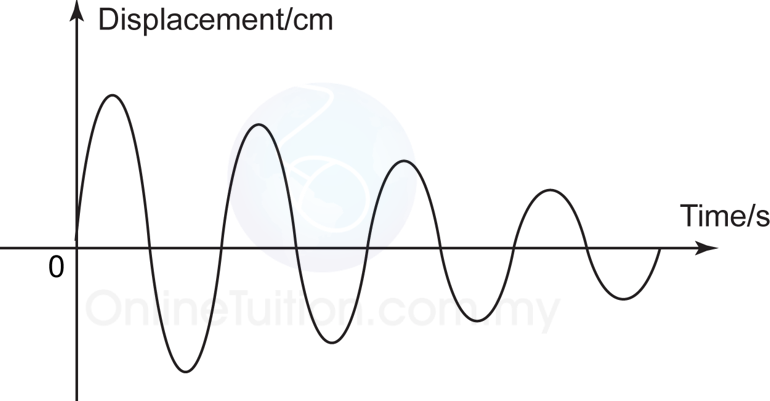Question 1:
What is the meaning of damping?
Answer:
What is the meaning of damping?
Answer:
Damping is the decrease of the amplitude of an oscillating system due to losing energy to the surrounding.
Question 2:
Sketch a graph of displacement against time for a system experiencing damping.
Answer:

Sketch a graph of displacement against time for a system experiencing damping.
Answer:

Question 3:
State three examples of the effects of resonance in our daily lives.
Answer:
Resonance is a phenomenon where an oscillating object oscillates with very high amplitude when the frequency of the external force exerted on the system equal to the natural frequency of the system.
Effects of resonance in our daily lives:
1. Opera singer breaks a wine glass with her voice because of resonance.
2. In 1940, the hanging bridge Tacoma Narrows in Washington, USA collapsed due to strong winds which caused the bridge to oscillate with large resonance and amplitude.
3. The London Millennium Footbridge was opened in June 2000. This bridge experienced unexpected oscillations when 2000 pedestrians walked on it.
4. A moving bus produces excessive noise at certain speed when the frequency of the engine equal to the natural frequency of the bus.
(Choose any three)
State three examples of the effects of resonance in our daily lives.
Answer:
Resonance is a phenomenon where an oscillating object oscillates with very high amplitude when the frequency of the external force exerted on the system equal to the natural frequency of the system.
Effects of resonance in our daily lives:
1. Opera singer breaks a wine glass with her voice because of resonance.
2. In 1940, the hanging bridge Tacoma Narrows in Washington, USA collapsed due to strong winds which caused the bridge to oscillate with large resonance and amplitude.
3. The London Millennium Footbridge was opened in June 2000. This bridge experienced unexpected oscillations when 2000 pedestrians walked on it.
4. A moving bus produces excessive noise at certain speed when the frequency of the engine equal to the natural frequency of the bus.
(Choose any three)
Question 4:
How can resonance overcome damping of an oscillating system?
Answer:
The effect of damping can be overcome by applying periodic external force on the oscillating system. The periodic external force transfers energy into the oscillating system to replace the energy lost. The system is said to be in a forced oscillation.
In a force oscillation, if the frequency of the external force is equal to the natural frequency of the system, the system will oscillate with maximum amplitude, the oscillating system is said to be at resonance.
How can resonance overcome damping of an oscillating system?
Answer:
The effect of damping can be overcome by applying periodic external force on the oscillating system. The periodic external force transfers energy into the oscillating system to replace the energy lost. The system is said to be in a forced oscillation.
In a force oscillation, if the frequency of the external force is equal to the natural frequency of the system, the system will oscillate with maximum amplitude, the oscillating system is said to be at resonance.
